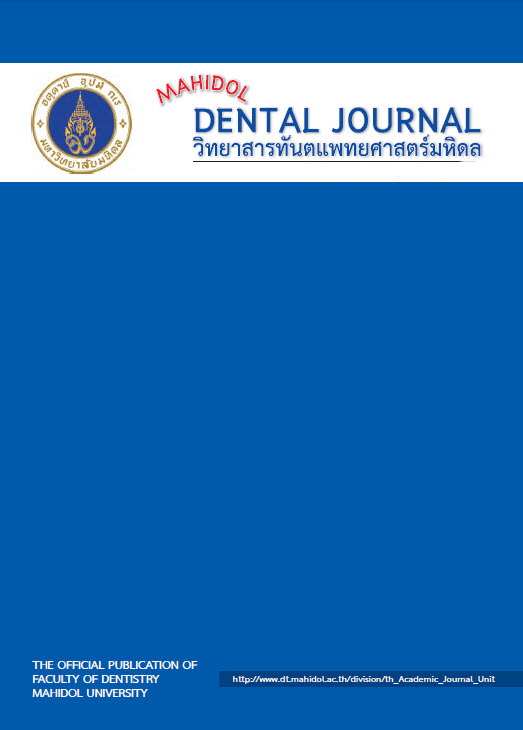The prediction formula of mesiodistal width of unerupted permanent canine and premolars from a group of Vietnamese, a preliminary study
Main Article Content
Abstract
The purpose of this study was to create new equations and to test their validity for estimating the sum of mesiodistal tooth sizes of unerupted canine and premolars of Vietnamese children. Two hundred and forty permanent teeth, including central incisors, through first molars were measured on twenty dental casts of Vietnamese. Correlation coefficient of all possible combinations of predictor were evaluated. Cross validation was also conducted both for selection of the prediction-model and validation of the prediction-result. Correlation coefficient and leave-one-out cross validation mean absolute error and root mean square error (LOOCV MAE and RMSE) were finished and indicated that the best prediction model was to use the width of mandibular central incisor and maxillary first molar (Md1Mx6) to predict the width of canine and premolars. Since there was no significant difference for sexual dimorphism (p>0.01), combined gender equations were developed from the regression analysis. The maxillary prediction formula was that Y= 0.77X+9.8 and the mandibular equation was that Y= 1.02X+5.1 where Y represented the predicted widths of canine and premolars and X represented the widths of mandibular central incisor and maxillary first molar (Md1Mx6). Validation as finished by LOOCV MAE and RMSE indicating that the error of these newly developed prediction equations was acceptable. LOOCV MAEs were 0.55 and 0.71 mm for maxillary and mandibular teeth, respectively. Further, these equations may be used with further investigation on larger sample or different specific geographic populations in Vietnam.
Article Details
References
2. Ballard ML, Wylie WL. Mixed dentition case analysis-estimating size of unerupted permanent teeth. Am J Orthod Oral Surg 1947; 33: 754–759.
3. Tanaka MM, Johnston LE. The prediction of the size of unerupted canines and premolars in a contemporary orthodontic population. J Am Dent Assoc 1974; 88: 798–801.
4. Nance HN. The limitations of orthodontic treatment: I. Mixed dentition diagnosis and treatment. Am J Orthod Oral Surg 1947; 33: 177–223.
5. de Paula S, de Oliveira Almeida MA, Lee PCF. Prediction of mesiodistal diameter of unerupted lower canines and premolars using 45° cephalometric radiography. Am J Orthod Dentofac Orthop 1995; 107: 309–314.
6. Staley RN, Hoag JF. Prediction of the mesiodistal widths of maxillary permanent canines and premolars. Am J Orthod 1978; 73: 169–177.
7. Steyerberg EW. Validation of Prediction Models. In: Clinical Prediction Models. Statistics for Biology and Healt. New York: Springer US, 2009, pp. 299–311.
8. Refaeilzadeh P, Tang L LH. Cross-Validation. In: Liu L, Özsu MT E (ed) Encyclopedia of database systems Boston, Ma: Springer US, 2009, pp. 532–8.
9. Donatelli RE, Lee SJ. How to test validity in orthodontic research: A mixed dentition analysis example. Am J Orthod Dentofac Orthop 2015; 147: 272–279.
10. Shao J. Linear model selection by cross-validation. J Am Stat Assoc 1993; 88: 486–94.
11. Molinaro AM, Simon R, Pfeiffer RM. Prediction error estimation : a comparison of resampling methods. Bioinformatics 2005; 21: 3301–3307.
12. Memon S, Fida M. Development of a prediction equation for the estimation of mandibular canine and premolar widths from mandibular first permanent molar and incisor widths. Eur J Orthod 2012; 34: 340–344.
13. Brito FC, Nacif VC, Melgaço CA. Mandibular permanent first molars and incisors as predictors of mandibular permanent canine and premolar widths: applicability and consistency of the method. Am J Orthod Dentofacial Orthop 2014; 145: 393–8.
14. Proffit W, Fields H, Sarver D. Contemporary Orthodontics 7th ed. St. Louis, MO: Mosby Elsevier, 2007. Epub ahead of print 2007. DOI: 10.1038/sj.bdj.2012.829.
15. Hunter WS, Priest WR. Errors and discrepancies in measurement of tooth size. J Dent Res 1959; 39: 405–414.
16. Wickham H, Francois R, Henry L, et al. dplyr: A Grammar of Data Manipulation. R package version 0.7.4., https://cran.r-project.org/package=dplyr (2017, accessed 28 February 2018).
17. Kassambara A. ggpubr: ‘ggplot2’ Based Publication Ready Plots.R package version 0.1.6., https://cran.r-project.org/package=ggpubr (2017, accessed 28 February 2018).
18. R Core Team (R Foundation for Statistical Computing). R: A Language and Environment for Statistical Computing, https://www.r-project.org/ (2013, accessed 28 February 2018).
19. Bland JM, Altman DG. Statistical methods for assessing agreement between two methods of clinical measurement. Lancet 1986; 1: 307–10.
20. Bland JM, Altman DG. Applying the right statistics: analyses of measurement studies. Ultrasound Obstet Gynecol 2003; 22: 85–93.
21. Lehnert B. BlandAltmanLeh: Plots (Slightly Extended) Bland-Altman Plots. R package version 0.3.1., https://cran.r-project.org/package=BlandAltmanLeh (2015, accessed 28 February 2018).
22. Daniels B. CROSSFOLD: Stata module to perform k-fold cross-validation, https://ideas.repec.org/c/boc/bocode/s457426.html (2012, accessed 28 February 2018).
23. Chai T, Draxler RR. Root mean square error (RMSE) or mean absolute error (MAE)? -Arguments against avoiding RMSE in the literature. Geosci Model Dev 2014; 7: 1247–1250.
24. Starkweather J. Cross Validation techniques in R: A brief overview of some methods, packages, and functions for assessing prediction models. [cited 2016 Dec 9]., https://it.unt.edu/sites/default/files/crossvalidation1_jds_may2011.pdf (2011).
25. Jaroontham J, Godfrey K. Mixed dentition space analysis in a Thai population. Eur J Orthod 2000; 22: 127–134.
26. Paredes V, Gandia JL, Cibrian R. A new, accurate and fast digital method to predict unerupted tooth size. Angle Orthod 2006; 76: 14–19.
27. Hucal IMB. Prediction of the size of unerupted canines and premolars in a Northern Manitoban Aboriginal population 2000. Epub ahead of print 2000. DOI: 10.1016/S0889-5406(05)81335-6.
28. Suazo I, Cantín M, López B, et al. Sexual Dimorphism in Mesiodistal and Bucolingual Tooth Dimensions in Chilean People. Int J Morphol 2008; 26: 609–614.
29. General Statistics Office. Statistical Yearbook of Vietnam 2015. Hanoi, Vietnam: Statistical Publishing House, 2017.
30. Seo S-H, An H, Lee S-J, et al. Mixed dentition analysis using a multivariate approach. Korean J Orthod 2009; 39: 112.
31. Efron B, Tibshirani R. Bootstrap methods for standard errors, confidence intervals, and other measures of statistical accuracy. Stat Sci 1986; 1: 54–77.


